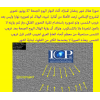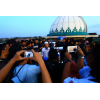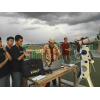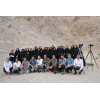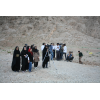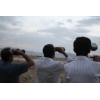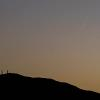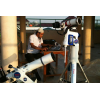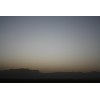Visibility of Ramadan Crescent 1435 AH
- When to Observe Ramadan Waxing (NEW) Crescent ?
- Ramadan Waxing (NEW) Crescent Observation Results
- The OFFICIAL First Day in Different Countries
- When to Observe Sha'ban Waning (OLD) Crescent ?
- Sha'ban Waning (OLD) Crescent Observation Results
When to Observe Ramadan Waxing (NEW) Crescent ?
The geocentric conjunction (Geocentric New Moon) will occur Inshalla on (Friday 27 June 2014) at 08:09 UT.
Sighting the new crescent on (Friday 27 June 2014) and (Saturday 28 June 2014) is shown in the below graphs using the program Accurate Times by Mohammad Odeh according to Odeh criterion. Where:-
- It is impossible to see the crescent from the areas located under the red color. Because either the Moon on this day sets before the Sunset and/or the topocentric conjunction occurs after the Sunset.
- The crescent is expected to be seen by optical aid only from the areas located under the blue color.
- The crescent is expected to be seen by optical aid from the areas located under the magenta color. In these areas the crescent could be seen by naked eye if the atmospheric conditions are superb and the observer is experienced.
- The crescent is expected to be easily visible by naked eye from the areas located under the green color.
- The crescent cannot be seen from uncolored areas, even though the Moon sets in these locations after the Sunset and the topocentric conjunction occurs before the Sunset, but the Moon is not sufficiently illuminated in order to be seen as crescent even by optical aid.
- Kindly notice that the below graph shows the possibility of seeing the crescent from areas between 60 degrees north of Equator down to 60 degrees south of Equator.


According to the Universal Hejric Calendar (UHC), which is based on the calculated crescent visibility, the start of this month in the Eastern Region will be on Sunday 29 June 2014 and in the Western Region will be on Saturday 28 June 2014. Kindly notice that the UHC is a pre-calculated calendar, which adopts a certain criterion to start the new Hejric month. Your country/organization might adopt different criterion to start the new Hejric month. So it is highly advised to read the UHC website before giving any judgment.
- Results of seeing the crescent, and the first day of the month in different countries will be added here Inshalla as we receive the reports from ICOP's members. If you wish to be a member in ICOP, or to know more about it, kindly click here.
Ramadan Waxing (NEW) Crescent Observation Results
Fri 27 June 2014
Algeria
Mr. Billal Bensalah said: "تمت محاولة رؤية الهلال من طرف مجموعة من 7 أشخاص (نادي الفلك لجمعية أنغام الحياة، القرارة، جنوب الجزائر) "
Brunei Darussalam
Mr. Hazarry Haji Ali Ahmad said: "MUSLIMS in the Sultanate of Brunei Darussalam will begin fasting tomorrow (29 June 2014) as the moon was not sighted at all the assigned locations yesterday. The moon set earlier after the sun set. The Syariah High Court Judge, Dato Seri Setia Ustaz Hj Metussin Hj Baki, relayed His Majesty the Sultan and Yang Di-Pertuan of Brunei Darussalam’s command on the start of Ramadhan on national radio and television yesterday evening. The Brunei-Muara moon-sighting event was held at DST headquarters at Tungku Highway. Previously it was held at Bukit Shahbandar in Jerudong. The other moon-sighting locations were Bukit Agok and Bukit Ambok in Tutong and Bukit Lumut in Belait. "
Egypt
Germany
Eng. Martin Elsaesser said: "The weather cleared around one hour after conjunction with good enough skies. As the moon would set before the sun today i had to observe during the day. I used an optimized imaging system to observe the young crescent, starting around 11:00 (UT+2). The imaging system allowed to detect the crescent, despite the elongation from the sun being less than 5.5°. The difference in brightness between the crescent and the background was initially well below 1% so quite impossible to see with the eye. I did not even try visual observation under these conditions. I could first detect the crescent around 11:20 but it was not very clear. Another gap around 13:00 provided a better view. I had to use a star-diagonal for the second series so the crescent orientation is now inverted."
Ghana
Mr. Abdul-Aziz Anyang said: "According to the National Hilal conference which was held in the Western regional capital of Ghana, the counting for today June 27 was the 29th day of Shaban, hence the first sighting to be conducted at our sunset local time. Though it was not expected to be seen as the moon sets just 13 minutes after the sun, a report came from the Eastern region (Koforidua) that it was seen by only one person and hence it was adopted and announced officially by the office of the National Chief Imam. This sighting report is doubtful as a 10 hours old new moon cannot be seen. "
Indonesia
Mr. AR Sugeng Riyadi said: "The New Crescent of Ramadhan 1435 AH was NOT SEEN from Assalaam Observatory, Pabelan Kartasura Sukoharjo - Surakarta Central Java Indonesia. And also from all other locations in Indonesia. We are about 150 moslem from Solo Raya, IAIN Walisongo Semarang,IAIN Surakarta, all students of CASA (Club Astronomi Santri Assalaam) tried to observe the moon and we could only see the sunrise near to the leg of Merbabu mountain. According to the Government Itsbat, the 1st Ramadhan 1435 AH in Indonesia will be on Sunday, 29 June 2014. Marhaban Yaa Ramadhan... :-)"
Nigeria
Mr. Qamarudeen Muhammad said: "it was cloudy as result of rain that fell around 6pm local time"
Dr. Usman El-Nafaty said: "There were many of us at our local mosque here in Bauchi Nigeria around Maghrib time and many of us attempted sighting the crescent. However the weather was cloudy on the western horizon so nothing could be seen."
Saudi Arabia
United States
Mr. Jim Stamm said: "New Moon Crescent Observation Report ====================================== Observed: Friday; June 27, 2014 - 19:47 (Local) Location (WGS 84) = Tucson, Arizona (USA) Longitude = 110.9525 W Latitude = 32.3886 N Elevation = 837 meters Time Zone = -7.0 hours Surface conditions at location: Temperature = 34 °C Humidity = 9 % Pressure = 29.88 in. This observation was under the clearest and steadiest sky that I can remember. The usual 2 degree wide band of translucent atmosphere along the horizon was not evident. Topocentric and local time values from “Accurate Times”: Sunset (at sea level) = 19:40 Moonset (at sea level) = 19:54 Time from new moon at 19:47 = 18 hr. 54 min. Moon lag time = 14 min. Relative Altitude = 2.5 degrees Elongation from sun = 9.7 degrees Crescent width = 13 arc seconds Illumination = 0.72 percent Crescent first observed through 8” SC telescope: Time = 19:47 Moon Altitude = -0.5 degrees Final observation with telescope: Time = 19:48 Moon Altitude = -0.7 degrees I did not invite others to join me in this observation because I did not expect to see anything, but being the Ramadan crescent, I felt compelled to make the attempt. I set up at a location that gave me an unobstructed horizon to under -0.3 degrees. Jupiter at 12 degrees altitude was as clear and crisp as though it was at an altitude of 50 degrees - before the sun had set. The bands were not distinct, but the image was steady, and there was noticeable detail on the surface, I slewed to Procyon, but could not see that star. I usually have to wait 12 minutes or more after sunset before it is dark enough to see a close crescent, so I checked alignment and focus for several minutes and then slewed to the position of the crescent. The Earth (horizon) was already within the field of view of the eyepiece. I did not immediately see any crescent, and maybe a minute later (with so little time, I failed to turn on my WWV radio) I began scanning a little back and forth in declination. In a few seconds I saw a familiar yellowish crescent. It was right where I had centered the scope to begin with. I tried to improve the focus and the image disappeared. I set the focus back to the correct numbered setting and the image reappeared, but it was more pinkish - orange this time. It was also distinct but shorter than the first observed crescent. I was convinced that I was seeing a real crescent (rather than those false white crescents that populate this type of observation), but as I was trying to confirm for certain, the image set behind the trees on the horizon. At that time, I looked at my watch, and estimated first contact at 19:47 and setting at 19:48 Again, while I was confident that I had seen the crescent, two things troubled me. If I had acquired Procyon at 1.5 degree altitude I could have been absolutely sure of my pointing and focusing. Also, previous thicker crescents had exhibited much more arc-length under poorer skies as they set. Primarily because of these two aspects, I can not say for 100% certainty that I saw the crescent during this observation. Stamm added later: This particular observation, if completely valid, was the result of rare and unusual circumstances. I was able to find an observing location that provided a negative horizon over an area that was currently in a prolonged stable high pressure area. Atmospheric particulates and water vapor had been removed from the air, and turbulence must have been close to zero. Consequently, my line of sight was unusually optimal for astronomical observing. The kind of skies that the great observatories are located under. Practical visibility models can not assume these conditions all of the time or they would be meaningless. I believe that for the most part, the models are a reflection of actuality - with one little exception. "
Sat 28 June 2014
Algeria
Mr. Hocine Chikh Aissa said: "28 people were present in N'tissa station, using 5 binoculars. The crescent of Chawal 1435 was seen by naked eyes by only Two people. We have observed Jupiter. The teams of observation in Merkich station of ben isgen have seen the crescent by binocular (20*60). "
Australia
France
Germany
Eng. Martin Elsaesser said: "As thunderstorms and rain were predicted for the evening i tried a first observation before noon. The weather conditions were very bad with many clouds and strong haze in between. The imaging system allowed to get at least some image of the crescent, despite the permantly changing conditions. The weather in the evening was as bad as predicted with a lot of rain, so no chance to observe after sunset."
India
Mr. Mohammed Mohsin Khan said: "Today Saturday 28 June 2014 / 29 Shaban 1435 in India. Here in Mumbai Sunset was at 07:20 pm IST and Moonset was at 08:03 pm IST. so there was 43 mins difference, Moon age : 29hrs, Altitude : 8.81, Phase : 1.63, but Sky was cloudy hence Crescent has not been sighted in Mumbai and in Most Parts of India. Moon-Sighting Committee have officially announced that Sunday 29 June 2014 is the 30th Shaban1435 and 1st Ramadan 1435 will fall on Monday 30 June 2014. Ramadan Mubarak to all Muslims."
Indonesia
Mr. AR Sugeng Riyadi said: "On Saturday, 28 June 2014 the new Crescent of Ramadhan 1435 AH was SEEN from Makasar, Kupang, Biak, Kolaka, Gresik, Padang, Manado, Aceh, and Solo. The crescent picture was taken by M.Yusuf at Kupang Indonesia. He's an Astrophotographer of Bosscha Observatory Bandung Indonesia."
Iran
Mr. Hossein Janghorbani said: "Mr. Hossein Janghorbani said: "Mr. Hossein Janghorbani said: "Mr. Hossein Janghorbani said: “In the name of God” Ramadan Crescent Observation Report Astronomy and Geophysics Center of Shahreza – The Crescent Association of Shahreza Report by: Hossein Janghorbani (Najm-al-Sepehr) – Manager of Shahreza Crescent Association and Red Crescent’s Astronomy and Geophysics Center Date: Saturday, 06/28/2014 Location: Damzad foothills in the East of Shahreza (latitude: 32 00 N, longitude: 51 52 E, elevation: 1850m from sea level, time zone: +4.5 GMT) Equipments: one sets of 15*70, three sets of 20*90 binoculars, one sets of 20*80 binocularsm, one compass. Atmospheric condition: cloudy in western horizon. Horizon obstacles: 2° Apparent sunset: Not Seen Results: The crescent moon was not seen because of the clouds in the western horizon. Observers: 1.Hosein Janghorbani 2.Ali Janghorbani 3.Reza Janghorbani 4.Davoud Javeri 5.Mohammad Javad Nikeghbal 6.Javad Amiri 7.Seyed Abolfazl Kahangi 8.Seyed Moslem Rezvani 9.Alireza Mojiri 10.Shahram Rahmati 11.Ghasem Zamani 12.Arezoo Tabibian 13.Zahra Falahi 14Mahsa Khaje 15.Mohadese Alinezhad 16.Zahra Farokhpur 17.Roshanak Sahba 18.Saba Sahba 19.Saghar Sahba 20.Razieh Aligholi 21.Nazanin Piruzmandan 22.Fatemeh Izadi 23.Fatemeh Tavakoli 24.Ziba Hafar 25.Maryam Shahcheraghi 26.Zinat Ghermezi 27.Roya Ghermezi 28.Fahimeh Azadi 29.Fahimeh Ghobadi 30.Zahra Izadi 31.Zahra Momenian 32.Tayebeh Shafiee 33.Narjes Zare 34.Saeed Momaiez 35.Hamid Reza Elahinezhad "
Netherlands
Mr. Sander Helmig said: "The cloudy weather made it impossible to sight the crescent. "
Nigeria
Dr. Z.Sani Mustapha said: "The moon although no sighted must have appeared this evening. The moon was sighted on the 26th at exactly 4.51 a.m. On the 27th the moon can be visible at around 5.50.a.m. It cannot be sighted on the 28th day. Therefore Sha'ban has 29 days."
Saudi Arabia
South Africa
Spain
Prof. Yasin Puertas said: "Salam Aleikum, Since we could only see the hilal with binoculars and couldn't see it with naked eyes, we will wait until further notifications from other parts of North Africa to the West to confirm our sighting. Inshallah, tomorrow will be first of Ramadan in Melilla, Spain. Ramadan Mubarak Said!"
Sri Lanka
Mr. Nular Bary said: " Assalamualaikum W R W B. REMARKS:I couldn't see the New moon of Holy Month Ramadan from my location till 6:40pm from Mahrib our sunset was at 6:29pm The New Moon has been sighted in so many other places in the country just after Mahrib Hence our Colombo Grand Mosque Hilaal Committee declared to start the Holy Month of Ramadan on Sunday 29th."In Sha Allah" RAMADAN MUBARAK TO ALL"
Tunisia
United Arab Emirates
Eng. Mohammad Odeh said: "The main observer was Ibrahim Abu Ghneam, and I logged in to the PC remotely to provide some assistance. The crescent was very clear despite the very bad atmospheric conditions. AOD was larger than 1.1 for 500nm! Important Note: This crescent was seen at daytime NOT after sunset."
United States
Dr. Javad Torabinejad said: "I arrived at my sighting location at 9:03 pm EDT (sunset: 8:46 pm). Using a pair of binoculars (7X50), I started looking for the crescent in a hazy and mostly cloudy western horizon. I stayed there till around moonset (moonset: 9:33 pm). Mr. Jim Lockyer of Wildomar, CA informed me that: "The moon was visible to the naked eye at/or about 8:24 PST.""
The OFFICIAL First Day in Different Countries
Sat 28 June 2014
1 . Cote dIvoire
2 . Ghana
3 . Nigeria
4 . Turkey
5 . Yemen
Sun 29 June 2014
1 . Algeria
2 . Australia
3 . Bahrain
4 . Brunei Darussalam
5 . Egypt
6 . Indonesia
7 . Iran
8 . Iraq
9 . Jordan
10 . Kuwait
11 . Lebanon
12 . Libya
13 . Morocco
14 . Oman
15 . Palestine
16 . Qatar
17 . Saudi Arabia
18 . South Africa
19 . Spain
20 . Sri Lanka
21 . Sudan
22 . Syria
23 . Tunisia
24 . United Arab Emirates
Mon 30 June 2014
1 . India
2 . Pakistan
When to Observe Sha'ban Waning (OLD) Crescent ?
The geocentric conjunction (Geocentric New Moon) will occur Inshalla on ( Friday 27 June 2014 ) at 08:09 UT.
Sighting the OLD crescent on ( Friday 27 June 2014 ) and on ( Thursday 26 June 2014 ) is shown in the below graphs using the program Accurate Times by Mohammad Odeh according to Odeh criterion. Where:-
- It is impossible to see the OLD crescent from the areas located under the red color. Because either the Moon on this day rises after the Sunrise and/or the topocentric conjunction occurs before the Sunrise.
- The crescent is expected to be seen by optical aid only from the areas located under the blue color.
- The crescent is expected to be seen by optical aid from the areas located under the magenta color.. In these areas the crescent could be seen by naked eye if the atmospheric conditions are superb and the observer is experienced.
- The crescent is expected to be easily visible by naked eye from the areas located under the green color.
- The crescent cannot be seen from uncolored areas, even though the Moon rises in these locations before the Sunrise and the topocentric conjunction occurs after the Sunrise, but the Moon is not sufficiently illuminated in order to be seen as crescent even by optical aid.
- Kindly notice that the below graph shows the possibility of seeing the crescent from areas between 60 degrees north of Equator down to 60 degrees south of Equator.

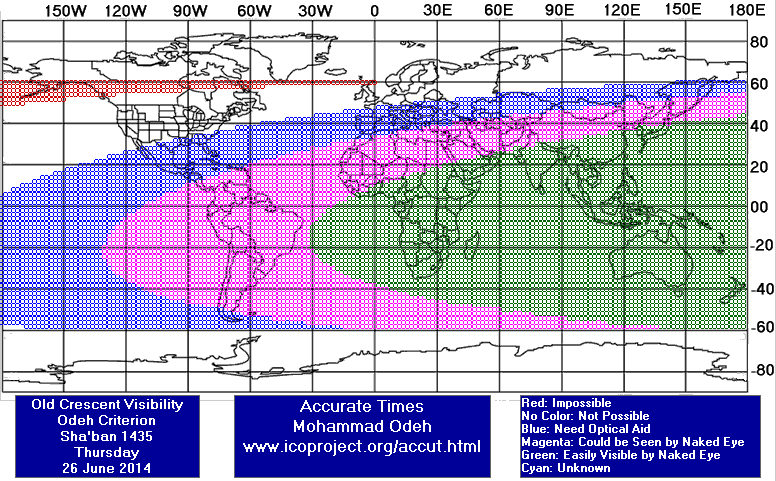
Sha'ban Waning (OLD) Crescent Observation Results
Thu 26 June 2014
France
Germany
Eng. Martin Elsaesser said: "I had an interesting observation this morning. I tried to see the crescent visually before sunrise. As this would be difficult, i brought an good visual telescope with an imaging system mounted on top. Both views were perfectly aligned, so the imaging system would confirm that i was looking at the correct spot. I used Venus and Aldebaran for alignment and to check focus. The imaging system showed the crescent immediately after it rose above the trees. I tracked it for 30 minutes till after sunrise and tried all the time to see it with the visual telescope but could not. A few times i thought it might be there but i could not confirm it. The skies were ok, the horizon was clear enough, so i had hoped to see it. Maybe i should have driven to the mountains. I also did not bring all of the optimized visual system, so there is room for improvement. I measured a contrast of 1.5% in the images, so the crescent was 1.5% brighter than the background. But this was with a red-filter only, with sensitivity going all the way to 1000nm. Still, an interesting observation giving a first comparison of actual contrast-levels."
Indonesia
Mr. AR Sugeng Riyadi said: "Alhamdulillah we could see the old crescent of Sya'ban 1435 H from Assalaam Observatory, Pabelan Kartasura Sukoharjo-Surakarta Central Java Indonesia. We are (Mr. Darmawan RHS, Ahmad Abdus Salam Aura Rusyda-my son) try to observe the moon after shubuh prayer, at the 5th floor of Assalaam Observatory on Thursday, 26 June 2014. The moon was seen before sunrise until 10 minutes after sunrise by teleskop. And the moon still captured until 40 minutes after sunrise by ccd. "
Iran
Kuwait
Nigeria
Mr. Qamarudeen Muhammad said: "Due to cloudy horizon at eastern sky here at Ilorin I couldn't sighted the wane crescent this morning after subhi prayer"
Dr. Z.Sani Mustapha said: "The crescent was seen the previous day (Wednesday) at 4.51am equivalent to 26th of Sha'aban.. "
Saudi Arabia
United States
Mr. Jim Stamm said: "Under a very clear sky I scanned the area where the old moon would be. I was not sure of my pre-pointing and focus. The altitude of the crescent was about 6 degrees, but I saw nothing through a 20 cm S-C telescope. A full report, detailing conditions can be had by requesting such from stammjim@gmail.com"
Fri 27 June 2014
Indonesia
Mr. AR Sugeng Riyadi said: "The old crescent of Sya'ban 1435 H was NOT SEEN from Assalaam Observatory, Pabelan Kartasura Sukoharjo-Surakarta Central Java Indonesia, because the east horizon was hazy and the altitude of the moon was very low."

